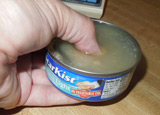How Much is Inside A Pound of Spaghetti?
How much water is absorbed when cooking a pound of spaghetti?
By Rob Cockerham |
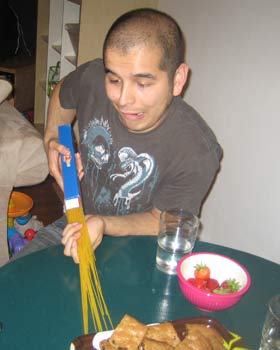
Spaghetti.
Like hamburger meat and steamed broccoli, it is a cornerstone of the American dinner. It is cheap, filling and nutritious. Sure, most of us enjoy dry spaghetti, straight from the box. But as an Italian-American friend of mine recently revealed, it is also delicious when cooked.
The first step in cooking spaghetti, like most 22 cent meals, is boiling a pot of water. The hot water isn't just used to heat up the spaghetti noodles, it is drawn into the noodles themselves, giving spaghetti an authentic watery flavor.
I know what some of you are thinking: "Rob, what about the hidden cost of all that hot water? And what about those empty calories that get sucked in during the cooking? Won't spaghetti dinners lay waste to my attractive figure? Isn't this experiment a lot like How Much is Inside Ramen?" Ah! Those are very good questions, but one haunted me above all others: How much water gets sucked inside a pound of spaghetti?
On Wednesday night, we decided to find out.
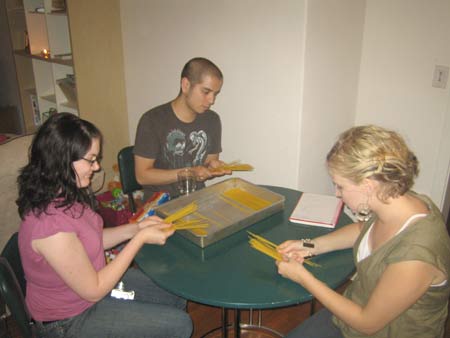
I had a one pound box stashed away that I had purchased for 65 cents at Food4Less. The store was in Manteca, so technically this spaghetti was imported.
The first step was to count the pieces of spaghetti. Brian, Michelle, Stacy and I each grabbed a handful and started counting noodles.
There were 448 pieces of spaghetti in a pound, about 125 yards of noodle.
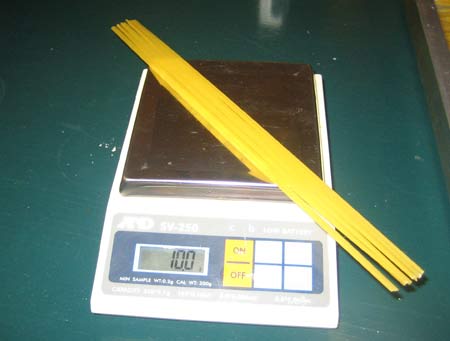
The dry noodles were 1/28th of an ounce, or almost exactly one gram each.
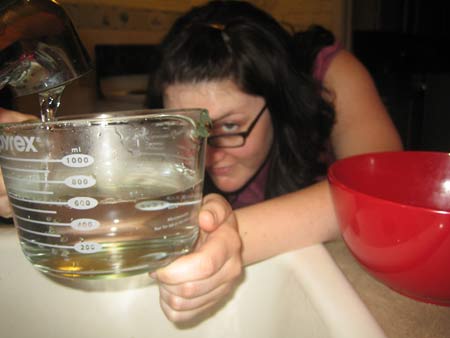
The next step was to boil a very precise quantity of water. Michelle measured out exactly five quarts of water into our test vessel, covered the pot with a lid, and set the pot to boil.

The action ground to a halt while we waited for the water to boil.
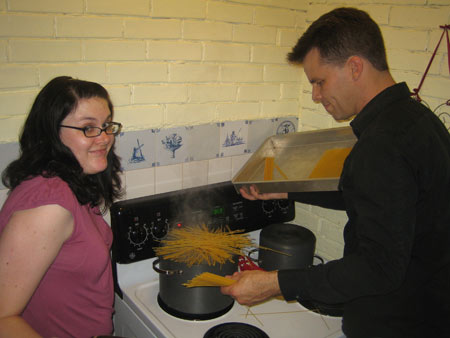
When the water began to boil vigorously, I dropped in the noodles. It is very important to let the noodles fall into the water separately, and to stir them often so that they do not fuse together into a spaghetti boulder.
Update: Spaghetti boulders have been renamed "spaghetti king", from their similarity to a Rat King (Thanks Cardhouse).
I discovered a flaw in the design of our spaghetti pot. The opening is too small.

After some quick thinking, the spaghetti was in, and the experiment was underway.

Cooking spaghetti should be easy, but it can be difficult to know just when to remove the spaghetti from the water.
To test if the spaghetti was done, we tried throwing it against the wall, to see if it would stick. I was a little worried that it would leave al dentes on the wall, but it was fine.

The first few strands were inconclusive, so we continued to throw spaghetti until a significant proportion was stuck there.
We had unknowingly summoned a flying spaghetti monster into our home.
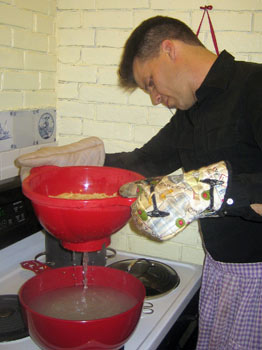
Satisfied that the spaghetti was finished cooking, and that it had absorbed a delicious portion of water, I prepared to drain the noodles.
I arranged a colander above a larger bowl (which had previously battled it out in bowl vs. colander melt off) so I could measure and calculate how much water was missing from the original 5 quarts.

The finished spaghetti was ready for weighing.
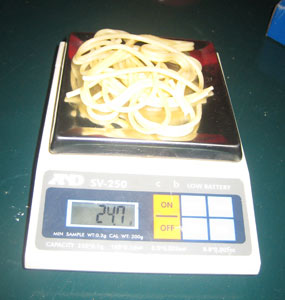
I selected 10 noodles for the scale, and prepared for the answer. The spaghetti weighed 24.7 grams. Ten noodles had gained 14.7 grams, or about 1.5 grams of water each, they now weighed more than twice what they weighed before cooking!
The 1 lb. package of noodles had gained 1.5 lbs, the equivalent to 24 fluid ounces of water. This was roughly enough liquid to fill a wine bottle!

No one was confident that measuring the drained spaghetti water would give an accurate result. We had all seen great clouds of steam rising out of the pot.
In the interest of being thorough, we measured the drained spaghetti water. We were missing 6 and a half cups, or 52 ounces.
Wow! It looked like we lost one bottle of wine to steam, and one bottle of wine to the spaghetti.

So there you have it!
Spaghetti absorbs one and a half times its own weight in water while it cooks.
When you eat a pound of cooked spaghetti, you aren't just gaining 1,680 calories, you are also eating 3 cups of water. That's why spaghetti is so mouth-watering!
Luckily, that water doesn't add any calories, and the 24 ounces of water can be easily obtained for free by a cost-conscious cook: Just use the waste water from your pickle jars and tuna cans!


